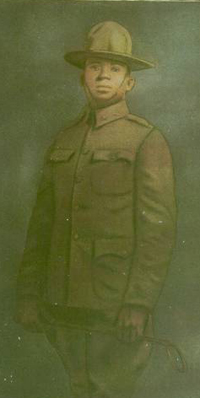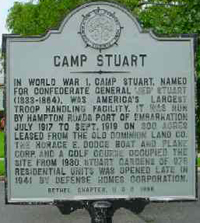Who was Tillman Hardy Harpole?
George Hicks, III and Carmon Weaver Hicks, Ph.D.
August 2011

Tillman H. Harpole (pictured at right) was born on March 24, 1891 in Conway, Arkansas. He was enrolled in the College of Liberal Arts and Sciences at the University of Illinois at Urbana from 1912-1914 (Sharpe, Harpole, and Hicks, 2009).
When the United States entered World War 1 on April 6, 1917, the debate about African American participation re-emerged. One side argued that advantages of equality could be achieved through military service while others cited the government’s failure to reward blacks for their wartime service. Once the war escalated, African Americans were welcomed into segregated units commanded by white officers. During the pre-war build-up of 1916, the Army recruited 650,000 volunteer soldiers but limited the number of blacks to 4,000 men. Thousands of black Americans enlisted but despite their eagerness to fight, the federal government limited their numbers.
Groups like the NAACP pushed for black officer training but officials feared that the race issue would harm the war efforts. Eventually, a compromise was reached. One officer candidate school was opened for black college graduates and 1,000 black officers would be trained.
Fort Des Moines IA was the perfect location – it was isolated from major cities and was home to an abandoned cavalry post built in 1901 on 400 acres. The units that had served there left in 1916 for duty along the Mexican border.
The first black officer candidates arrived in May 1917 – all were college graduates and faculty from Howard, Tuskegee, Harvard and Yale. The student officers were put through weeks of intensive training under Col. C.C. Ballou, his staff, and a group of 250 non-commissioned officers (sergeants) from the 9th and 10th Cavalry and the 24th and25th Infantry (Buffalo Soldiers). Training was expected to last for 90 days but at the end of that period, the War Department added another month to their training (Scott, 1919).
Harpole was a member of the first class of 639 men at the training camp at Fort Des Moines, Iowa. He attended from June 24 - October 14, 1917. He did not acquire military status while at camp but was considered a civilian candidate in training for a commission. On October 15, he was appointed as First Lieutenant, Infantry Section Officers Reserve Corps and entered active duty. He served with Company M, 372nd Infantry at Camp Funston, Kansas (Sharpe, Harpole, and Hicks, 2009).
Camp Funston was established as one of 16 divisional cantonment training camps during World War 1. Construction of the 2,000 acre camp began in the summer of 1917 and eventually encompassed approximately 1,400 building. Major General Leonard Wood commanded the camp. Nearly 50,000 recruits from the Great Plains trained there (Walter, 2002).
Later, Harpole was sent to Camp Stuart, Virginia (Hicks, 2006). It was located in Newport News and was run by the Hampton Roads Port of Embarkation from July 1917 - September 1919. The 300 acres for the camp was leased from the Old Dominion Land Company. The historical marker is pictured at right (www.historichamptonroads.com, 2011).

On March 30, 1918, Harpole left the United States headed to France with the 372nd Infantry Regiment, 93rd Infantry Division. The 369th, 370th and 372nd Regiments were assigned to the “provisional” (temporary) 93rd Division. The Army had no plans for employing these soldiers in combat; however, the French allies were short of manpower. They gladly accepted the offer of these troops to replace their losses. The three regiments were assigned to different French divisions, fought in several battles including attacks in the Champagne and Lorraine sectors (National Guard, 2011). The 372nd spent a period of training in the Argonne from June 6 - July 14 and was a part of the French 157th attached to the 10th Army Corps (Yankee negroes, 1919). They fought in the Meuse-Argonne Offensive between September 26 and October 8 (Greenfield, 2011). Harpole served in the Air Defense sector and was killed in action on October 5, 1918. The 369th and 372nd met fierce resistance against their assaults but they succeeded in capturing all of their objectives despite high losses (National guard, 2011).
Tillman H. Harpole was buried in Meuse-Argonne American Cemetery in Romagne, France, Plot B, Row 41, and Grave 03. Harpole was awarded the World War I Victory Medal and the World War Victory Button (silver). The name and latest address of the nearest relative was Mrs. Mary C. Harpole, wife, 31 Libby St., Phoebus, Virginia (Indianapolis, Recorder, 1936).
On January 21, 1937, the American Legion Post #249 in Indianapolis, IN was named in honor of Lt. Tillman H. Harpole (Hicks, 2006).
References
93rd division: The national guard educational foundation. Retrieved on July 31, 2011 from www.ngef.org/index.asp?bid=129
Greenfield’s John R. Canon, WWI: African Americans and world war I. Retrieved on July 22, 2011
from www.highland-ohio.com/cannon%20wwi%20photo.htm
Harpole post will observe labor day. (September 5, 1936). Indianapolis, IN: The Indianapolis Recorder.
Hicks, G. (October, 2006) Buffalo soldier research museum newsletter, vol 4, issue 4.
Indianapolis, IN: www.buffalosoldierresearchmuseum.org
Sharpe, A.H., Harpole, A., and Hicks, G. (2009). Veterans’ memorial project: Tillman Hardy Harpole. Retrieved on July 19, 2011 from http://www.uiaa.org/Urbana/veterans/display_veteran.asp?id=435.
Walter, B. and Fort Riley Historical and Archeological Society. (November 19, 2002 and 1998).
Camp Funston. Retrieved on July 22, 2011 from www.skyways.org/history/cfunston.html
Yankee negroes in horizon blue led way to Rhine: The stars and stripes. (April 4, 1919).
Retrieved on July 31, 2011 from www.oldmagazinearticles.com.
